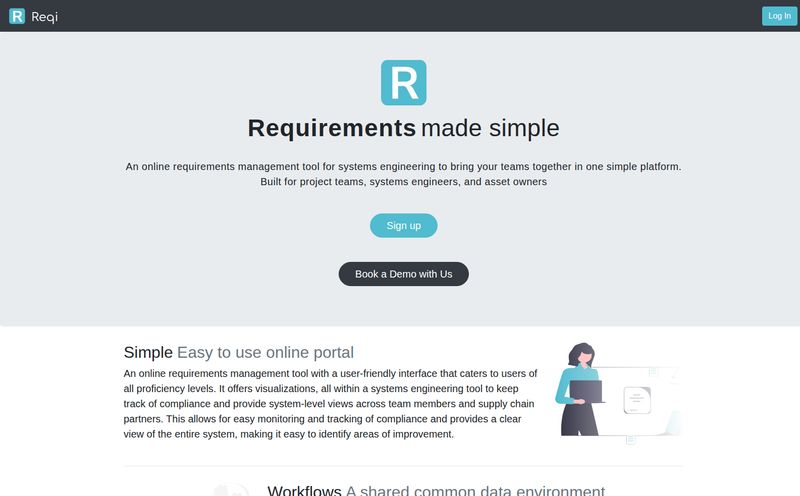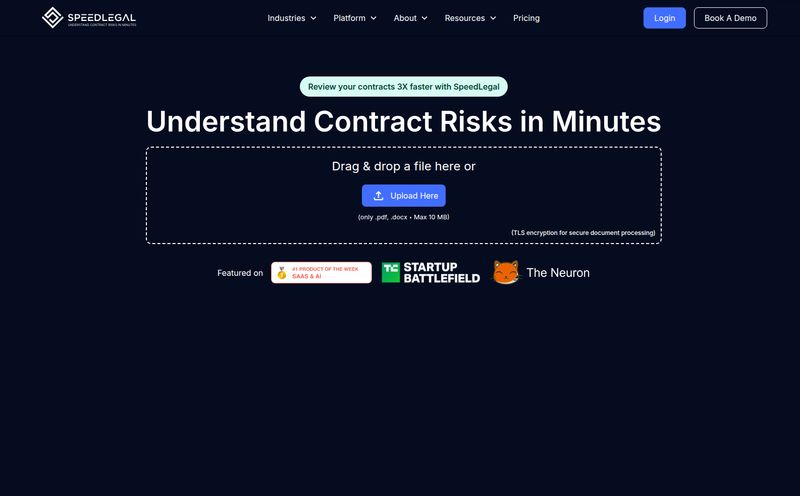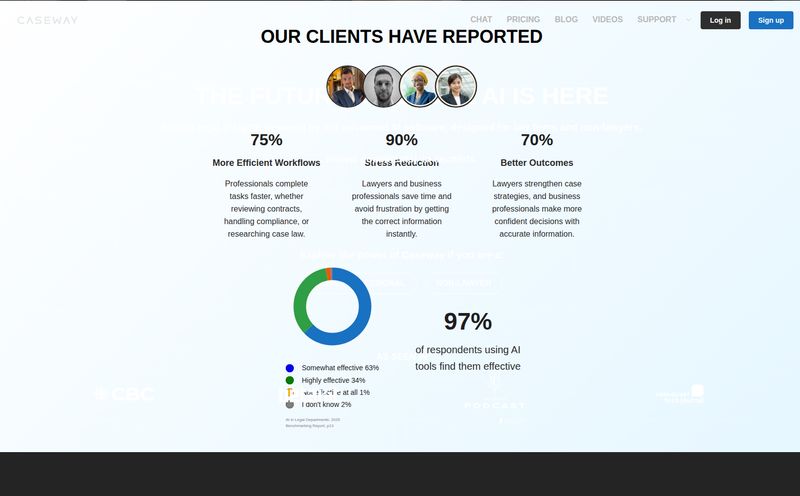Unless you're a lawyer, legal documents are a nightmare. It’s that sinking feeling you get when a 30-page PDF lands in your inbox, filled with dense legalese that seems specifically designed to be misunderstood. For years, as a small business owner and consultant, I've seen friends, clients, and colleagues sweat over contracts, NDAs, and terms of service agreements. The cost of getting a lawyer to look at everything can be astronomical, but the cost of not doing it can be even worse.
So, when tools started popping up that promised to use Artificial Intelligence to demystify this stuff, my ears perked up. One name that generated some buzz was Legal Robot. The pitch was simple and seductive: an AI that could read your contracts, analyze them against case law, and flag potential issues. Like a pocket-sized paralegal, ready 24/7. An amazing idea, right? But here's where our story takes a turn. What happens when the robot seems to have… powered down?

Visit Legal Robot
The Big Promise of Legal Robot
The concept behind Legal Robot was brilliant, I'll give them that. It wasn't about replacing lawyers, at least not in its most responsible application. It was about providing a first line of defense. The platform was designed to ingest a legal document—you could even snap a picture of it with your phone—and its machine learning models would get to work.
It would perform a linguistic and statistical analysis, comparing the language in your document to a massive database of other contracts and established case law. Think of it as a super-powered plagiarism checker, but instead of looking for copied sentences, it’s looking for weird, non-standard, or potentially predatory clauses. The goal was to give regular people a fighting chance at understanding what they were about to sign. It was meant to translate the gobbledygook into plain English and highlight areas where you should probably, definitely get a human expert involved.
What Was Under the Hood?
From what I could gather, the feature set was pretty focused on this core mission of automated analysis. We're talking about:
- Automated Document Analysis: The main event. Upload or snap a photo, and the AI does its thing.
- Contract Analytics: It wouldn’t just read; it would offer insights. For example, it could tell you if a clause was common or unusually restrictive.
- Legal Simplification: This is the holy grail for most of us. Turning “heretofore” and “indemnify” into language we can actually process.
- Compliance Tools: Helping to check if your documents meet certain regulatory standards, which is a massive headache for any business.
So, Where Did the Robot Go?
This is the part of the review that feels more like an investigative piece. If you try to visit the Legal Robot website today, you’re greeted not by a slick SaaS landing page, but by a stark white screen with an error message: “Connection timed out.” The Cloudflare error (a 522, for my fellow nerds) essentially means the browser's request got to the front door, but no one was home at the server to answer. The page also carries a gentle, slightly sad message from The Legal Robot Team: “We’ll be back soon! Sorry for the inconvenience but we’re doing maintenance or having trouble with our servers at the moment.”
But here’s the thing. In the fast-moving tech world, a “we’ll be back soon” message that stays up for an extended period is often a quiet tombstone. I’ve seen it happen dozens of times. A promising startup hits a wall—funding dries up, the tech doesn't pan out, the founders move on—and the server is the last thing to go. It's a digital ghost town.
While I can't say for certain they're gone for good, the signs aren't promising. It's a shame, because the idea itself had so much merit.
The Good, The Bad, and The AI Lawyer
Even if Legal Robot is just a ghost in the machine now, it's worth talking about the pros and cons of this type of service, because more will certainly follow in its footsteps. In fact, many already have, as the generative AI boom continues.
The Bright Side of Automated Analysis
The biggest win here is undeniable: time and access. For a freelancer staring at their first client contract or a startup founder juggling a dozen vendor agreements, a tool like this could be incredible. It provides instant analysis, helping you spot red flags without waiting (and paying) for your lawyer to get back to you. It's about empowering people to ask smarter questions. Instead of going to your lawyer and saying, “Can you read this?”, you can go and say, “The AI flagged clause 7.b as unusual; can you explain the risk here?” That’s a much more efficient and cost-effective conversation.
The Necessary Reality Check
Now for the cold water. The major drawback, and it’s a big one, is that law is about more than just words on a page. It’s about context, intent, and jurisdiction. An AI can compare text patterns, but it can’t understand the specific circumstances of your deal or the nuances of a recent court ruling in your specific state. I've always felt that relying solely on an automated tool for high-stakes legal decisions is like using WebMD to perform your own surgery. It’s a great resource for information, but it is absolutely not a substitute for a trained, experienced professional. The risk of an algorithm missing a subtle but critical detail is just too high.
What About the Price Tag?
This is another dead end in the investigation. There's no public pricing information available for Legal Robot, and with the site down, the pricing page is inaccessible. Typically, tools in this space operate on a SaaS model—a monthly subscription, perhaps with tiers based on the number of documents you can analyze. Some might offer a pay-per-document model. The lack of clear pricing, even in its heyday, often suggests a company is still figuring out its market fit or focusing on larger enterprise clients. Given the current situation, it's a moot point, but for any future AI legal tool, transparent pricing will be a huge factor in building trust.
Who Was This For, Anyway?
I believe the sweet spot for a tool like Legal Robot was always the little guy. The freelancers, the solopreneurs, the small business owners, the bootstrapped startups. Basically, anyone who feels that constant tension between needing legal oversight and not having a massive legal budget. It’s a tool for the agile and the under-resourced, a way to level the playing field just a little bit when facing off against larger corporations with entire legal departments on staff.
Final Thoughts on a Potentially Great Idea
The story of Legal Robot feels like a bit of a cautionary tale. It represents a fantastic, much-needed idea: using technology to make the law more accessible. The execution and longevity, however, seem to have fallen short. Whether it was due to technical hurdles, financial problems, or something else, its current offline status is a bummer.
But don't be discouraged. The concept is sound, and the demand is real. As AI continues to advance, we're going to see more sophisticated and reliable versions of this idea emerge. The key will be for users to embrace them as what they are: powerful assistants, not replacements for human judgment. They are the first read, the second opinion, the thing that helps you sleep a little better at night. But when it's time to sign on the dotted line, you still want a human being in your corner.
Frequently Asked Questions (FAQ)
- 1. Can a tool like Legal Robot replace a real lawyer?
- Absolutely not. Think of it as a powerful research assistant. It can flag potential issues and help you ask smarter questions, but it cannot provide legal advice or replace the nuanced understanding of a qualified attorney who knows your specific situation.
- 2. Is Legal Robot still in business?
- All signs point to no. As of late 2023 and into 2024, the website has been down with a “Connection timed out” error. While the company hasn’t made a formal announcement that I can find, prolonged downtime like this usually means a service is no longer operational.
- 3. Was it safe to upload sensitive documents to Legal Robot?
- This is a major concern with any cloud-based AI tool that handles sensitive data. The company's privacy policy and security measures would have been the key documents to review. For any similar service, you must be confident in their data handling protocols before uploading a confidential contract.
- 4. How did Legal Robot's AI actually work?
- It used a combination of Natural Language Processing (NLP) and machine learning. It analyzed the text of a legal document and compared its structure, language, and clauses against a huge dataset of existing contracts and case law to identify what was standard, what was unusual, and what might be a potential risk.
- 5. Are there good alternatives to Legal Robot?
- Yes, the AI-powered legal tech space is growing. Tools like LawGeex (now part of LegalSifter), Kira Systems, and even some features being built into contract lifecycle management (CLM) platforms offer similar analytical capabilities. Always do your research before committing to one.
- 6. Why is AI contract analysis so important for small businesses?
- It democratizes access to legal review. Small businesses often lack the resources for a full-time legal team. AI analysis provides a scalable, affordable first-pass review, helping them identify major risks in sales agreements, vendor contracts, and employment offers without an immediate, high-cost legal consultation for every single document.
References and Sources
- Analysis based on the former concept of the Legal Robot platform and the current status of its website.
- General industry knowledge of AI in the legal technology (LegalTech) sector.
- For historical context on the company, you can look up its profile on platforms like Crunchbase.



